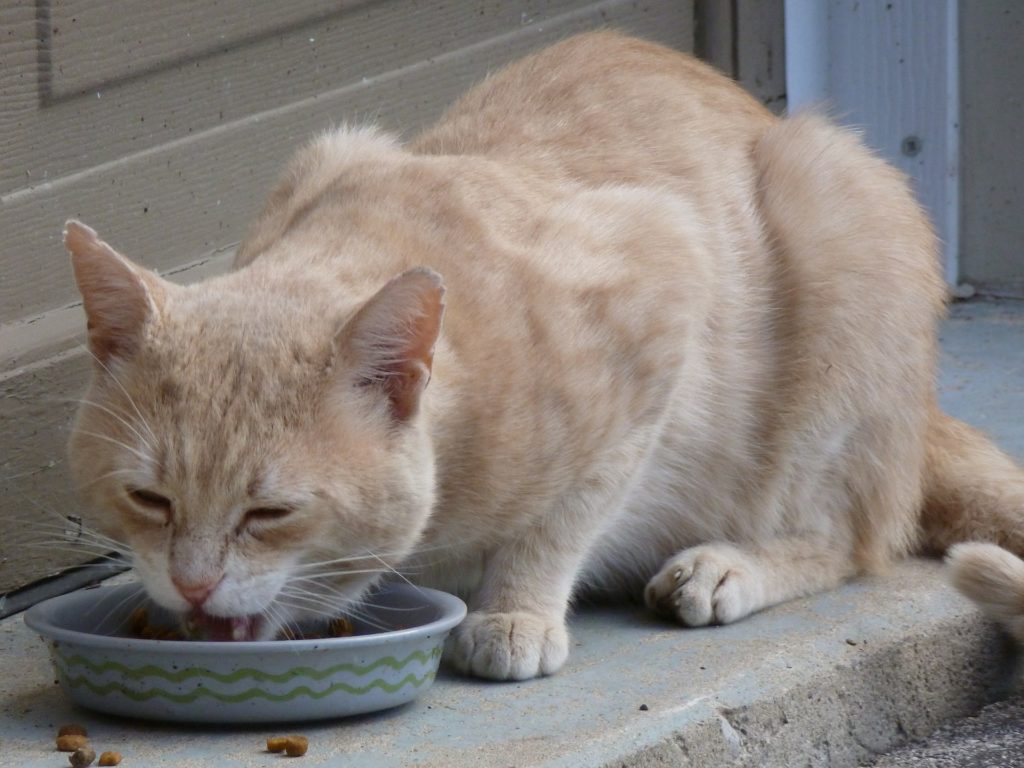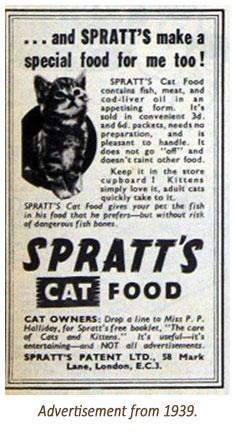
History of Pet Food Industry
How did we get here?
A Brief History of Commercial Pet Food
Updated: Sunday, August 26, 2018 03:25 PM Published: Monday, September 28, 2009 08:03 AM Written by Margaret Gates Founder of Feline Nutrition Foundation ©2018 Feline Nutrition Foundation
 Cats have been living with humans for a very long time. When people started growing and storing grain, having cats around became a very good idea. Everyone, people and cats, benefited from the arrangement. For almost the entire history of the human-cat relationship cats ate what they could catch – probably thinking how thoughtful it was of the humans to have great piles of rodent attractor around, just to lure their favorite meal right to them – and whatever scraps people would give them. Cats thrived on this primarily fresh caught diet, and rarely suffered from the diseases that are so prevalent today.¹
Cats have been living with humans for a very long time. When people started growing and storing grain, having cats around became a very good idea. Everyone, people and cats, benefited from the arrangement. For almost the entire history of the human-cat relationship cats ate what they could catch – probably thinking how thoughtful it was of the humans to have great piles of rodent attractor around, just to lure their favorite meal right to them – and whatever scraps people would give them. Cats thrived on this primarily fresh caught diet, and rarely suffered from the diseases that are so prevalent today.¹
The commercial pet food industry started in 1860 with James Spratt’s invention of the first dog biscuit in England. Made from vegetables, beef blood, wheat, and beet root, Spratt reportedly was inspired by observing sailors throwing hardtack to dogs at the docks. His biscuits were very popular and other companies soon began making their own versions. By 1890, commercial pet food manufacture had spread to the United States.²
It was in the 1900s that commercial pet food really gained popularity. In 1907, F.H. Bennett formed a company in New York City that began making Milk Bone™ dog biscuits. Ken-L-Ration® introduced canned horse meat for dogs after World War I, and Gaines Food® introduced canned cat food and dry meat-meal dog food in the 1930s. During World War II, when metal was rationed (and pet food was classified as “non-essential”), canned pet food wasn’t available and the production shifted to dry foods. By 1946, dry food represented 85% of the market.³ At this point there were two kinds of dry food: biscuits, or crumbled biscuits known as kibble, and pellets whose ingredients had to be hand mixed. After World War II, with the economy booming, people could afford the luxury of pet food. In the 1950s and 60s, many companies added pet foods lines to their “human lines” of products. Companies such as General Foods®, Quaker Oats®, Campbell’s® Soups, Mars®, Lipton®, Post®, Carnation® and Nabisco® saw pet foods as a profitable way to market by-products.⁴ Most canned cat food at this time was fish.⁵
The next big innovation came in the 1950s with the use of the extrusion process by Purina® (Dog Chow™ and Cat Chow™). The ingredients are cooked together in a liquid form, pushed through a mechanical extruder, which expands the food, and then it is baked.⁶ The end product is larger and lighter than either of the previous methods, which also gave the food a “more for your money” appeal. Convenience was the biggest marketing point with these foods. The foods must contain large amounts of starch for the extrusion process to work. Nutrients are added back in to make up for the loss due to being cooked twice at high temperatures. Fats and flavorings are sprayed on the end product to make them palatable.⁷
Companies began marketing their products as “complete” foods, and started the idea that feeding table scraps was actually dangerous. In 1964 the Pet Food Institute started a campaign warning consumers about the dangers of feeding table scraps and the importance of feeding processed food to pets.⁸ Dry foods especially were marketed to the owner through a myriad of shapes and colors and catchy names. The next big change came with the marketing of “prescription” foods, sold primarily through veterinarians. This was initially done by Hill’s® (which was purchased by Colgate Palmolive® in 1976) after their parent company had enormous success marketing toothpastes through dentists.⁹ Part of the message in this kind of marketing was that pet food is complicated and best left to the “professionals” who were the only ones who knew what pets really needed to eat.
Pet food manufacturers are regulated at the federal level by the FDA, under the Federal Food, Drug, and Cosmetic Act (FFDCA). Within the FDA, the Center for Veterinary Medicine (CVM) is responsible for the regulation of animal feed products, although they do not set any standards for pet food, and only regulate animal drugs, medicated feeds (which are almost entirely for livestock) and food additives.There is no pre-market approval requirement for pet foods.¹⁰
The FDA fulfills its mandate for pet food regulation by partnering with the Association of American Feed Control Officials (AAFCO), “an organization almost entirely independent of government control.” AAFCO has no enforcement authority and does not perform any analytical testing on pet food. A pet food manufacturer is only required to comply with the pet food regulations of the state in which it manufactures or sells its products.¹¹
©2018 Feline Nutrition Foundation
Source:
-
A. Prahl DVM, L. Guptill DVM, PhD, Dipl ACVIM, N. W. Glickman MS, MPH, PhD, M. Tetrick DVM, PhD, and L. T. Glickman VMD, DrPH, “Time Trends and Risk Factors for Diabetes Mellitus in Cats Presented to Veterinary Teaching Hospitals,” Journal of Feline Medicine and Surgery 9, no. 5, October 2007, 351-358.
-
Justine S. Patrick, “Deconstructing the Regulatory Façade: Why Confused Consumers Feed their Pets Ring Dings and Krispy Kremes,” Digital Access to Scholarship at Harvard (DASH), April 2006.
-
Patrick, “Deconstructing.”
-
Patrick, “Deconstructing.”
-
Christopher S. Cowell, Neil P. Stout, Mark F. Brinkman, Edward A. Moser, and Stephen W. Crane, “History of Pet Food Manufacture in the United States,” Small Animal Clinical Nutrition, 4th ed. Walsworth Publishing Company, 2000, 129.
-
Cowell and others, 129.
-
Cowell and others, 132-134.
-
Justine S. Patrick, “Deconstructing the Regulatory Façade: Why Confused Consumers Feed their Pets Ring Dings and Krispy Kremes,” Digital Access to Scholarship at Harvard (DASH), April 2006.
-
“Hill’s Pet Nutrition, Inc.,” Funding Universe. International Directory of Company Histories 27, St. James Press, 1999.
-
Justine S. Patrick, “Deconstructing the Regulatory Façade: Why Confused Consumers Feed their Pets Ring Dings and Krispy Kremes,” Digital Access to Scholarship at Harvard (DASH), April 2006.
-
Patrick, “Deconstructing.”

